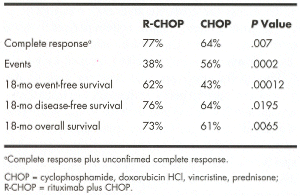Rituximab Plus CHOP in the Treatment of Elderly Patients With Diffuse Large B-Cell Lymphoma: An Update of the GELA Study
At the 2000 Annual Meeting of the American Society of Hematology, we presented the benefits of rituximab (Rituxan) combined with CHOP (cyclophosphamide [Cytoxan, Neosar], doxorubicin HCl, vincristine [Oncovin], prednisone), known as R-CHOP, in comparison with CHOP alone for the treatment of elderly patients with diffuse large B-cell lymphoma (DLCL).
At the 2000 Annual Meeting of the American Society of Hematology, we presented the benefits of rituximab (Rituxan) combined with CHOP (cyclophosphamide [Cytoxan, Neosar], doxorubicin HCl, vincristine [Oncovin], prednisone), known as R-CHOP, in comparison with CHOP alone for the treatment of elderly patients with diffuse large B-cell lymphoma (DLCL). It was an interim analysis of 328 patients with a median follow-up of 12 months. We present here an update of this study with a total of 399 patients included and a median follow-up of 18 months.
To be included in the study, a patient needed to be 60 to 80 years old and to have an untreated DLCL. Patients received eight cycles of standard CHOP every 3 weeks or eight cycles of R-CHOP (CHOP plus rituximab at 375 mg/m² the same day). Characteristics of the whole population did not change, with 60% of patients having a poor prognosis as described by the International Prognostic Index (IPI). Central histologic review confirmed DLCL in 87% of the cases. No statistically significant difference for the clinical presentation was observed between the two treatment arms.

Response at the end of the treatment was as follows: complete response plus unconfirmed complete response, 77% (R-CHOP) and 64% (CHOP); partial response, 9% (R-CHOP) and 7% (CHOP); progression during treatment, 9% (R-CHOP) and 22% (CHOP); death without progression, 5% (R-CHOP) and 6% (CHOP), P = .007.
Events were defined as disease progression, alternative new treatment, and death without progression. An event was observed in 56% of patients treated with CHOP (28% during treatment and 28% in responding patients) and in 38% of patients treated with R-CHOP (15% during treatment and 23% in responding patients), P = .0002. Eighteen-month event-free survival, disease-free survival, and overall survival are presented in the table above.
These results were identical if only patients with a confirmed DLCL were included in the analysis. The benefit of adding rituximab was observed in patients with good risk or poor risk according to the IPI or in patients younger or older than 70 years.
CONCLUSION: With a longer follow-up, the benefit of combining rituximab with CHOP for the treatment of elderly patients with DLCL was confirmed.
Click here to read Dr. Bruce Cheson's commentary on this abstract.
Highlighting Insights From the Marginal Zone Lymphoma Workshop
Clinicians outline the significance of the MZL Workshop, where a gathering of international experts in the field discussed updates in the disease state.